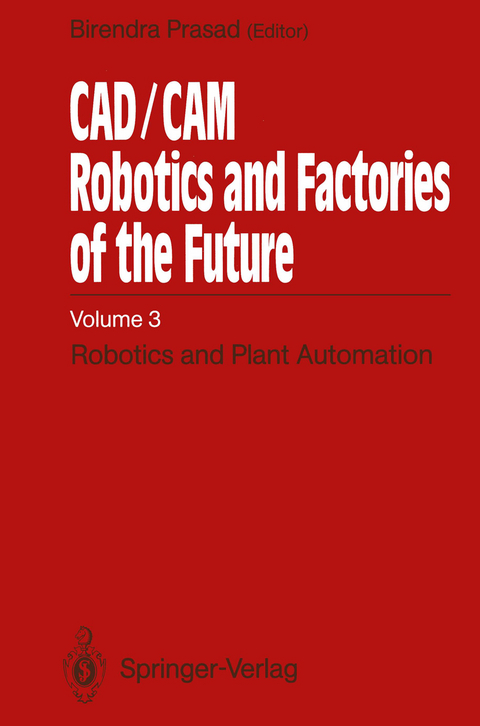
CAD/CAM Robotics and Factories of the Future
Springer Berlin (Verlag)
978-3-642-52328-1 (ISBN)
I: Planning for Automation: Introduction.- The Automated Manufacturing Project: Understanding Management's Concern.- Strategic Planning for the Factory of the Future.- I.1 Automated Systems.- Human Performance in Man-Robot System.- Review of Determining/Optimizing a Robot's Process Capability.- Automated Data Collection Workstation for Inventory Management.- Investigation of Computer-Aided Control of a Waterjet Robotic Workcell.- Automatic Decentralized Allocation of AGVs in a Cellular System.- Implementing a Transition Manager in the AMRF Cell Controller.- II: Automated Assembly: Introduction.- Investigation of Automatic Assembly Methods.- The Interrelationship of Parts Classification and Gripper Design for Automated Assembly.- CARA - The Next Generation.- Pin Assembly by Robot.- Automated Robotic Cell Configuration for Electronics Assembly.- III: Robot Programming and Simulation: Introduction.- ADAR: A New Vision of Tasks Programming for Robotized Industrial Workcell.- Robot Systems Software.- The Simulation of a Manufacturing Cell.- GROSS - Graphic Robot Simulation System.- Kinematic Simulation of Robotic Systems.- Simulation of Compliant Motions with Uncertainty.- IV: Kinematics, Dynamics and Path Planning: Introduction.- A New Departure in Programmable Robotic Manipulators.- Tunnel Following Problem of an Autonomous LHD Vehicle Operating in an Underground Mine.- A Robot Kinematic Gripper.- A Kinematic Study of a Robot and a Dextrous Hand.- Inverse Kinematic Analysis of Moving Base Robot with Redundant Degrees of Freedom.- Real-Time Obstacle Avoidance for Fast Mobile Robots.- Modeling, Trajectory Coordination, Control and Simulation of the Multiarm System.- Dynamic Characteristics of a PUMA 560 Manipulator, and a Complementary Tracking Control Strategy.-Kinematic Model Sensitivity to Geometrical Parameters Errors and its Impact on Robot Precision.- Flexible Manufacturing Using Modular Robotic Wrists.- V: Object Recognition, Imaging and Sensors: Introduction.- 3-D Modeling for Robotic Tactile Object Recognition.- An Imaging Proximity Sensor for Robotic Inspection and Assembly.- A Sensor System for Determining Position and Orientation of Robot Targets.- Learning Shape Features Using a Binary Tree Classifier.- Measurement System for Testing Magnetic Parameters of Thin Amorphous Ribbons and Metrologic Parameters of Displacement Sensor Using Amorphous Ribbons.- An Experimental Autonomous Articulated Robot That can Learn.- Development of 3-D Imaging Systems for Postal Automation.- Mailpiece Manipulation on the Basis of Partial Shape Information.- Singulation of Irregular Objects by Adaptive Robotics and Sparse Range Imagery.- A Multiview Image Acquisition System for Postal Parcels.- VI: Control: Introduction.- Application of Kalman Filters to Assembly Signature Monitoring Using Empirical Process Models.- Autonomous Distributed Control Through Flexible Communications.- Non-Homogenous Redundancy Management for Fault Tolerant Robots.- Reflex-Action Position Control and Two-Arm Load-Sharing Force Control With Adaptive Load Apportioning.- Performance Implications of Rendezvous in the Design of Multi-Task Robotic Systems.- A Microprocessor Based Speed ed Controller and Data Processor for Dynamic Testing of Rotor Blades.- A DSP Microprocessor Based Workstation for Expert Control.- VII: Motion Coordination: Introduction.- Lifting of an Object by Coordination of Two Planar Robots.- Dynamics and Coordination of Multiple Robot Arms Moving a Common Task Object.- Coupling of a Robotic Language with a Supervisor for a Simultaneous Adaptive Control of Two Robots.- VIII: Communication and Networking: Introduction.- Fiber Optic Factory of the Future.- MAP/TOP Functionality from User Perspective.- Robot Support System for Automotive Manufacturing Using MAP Communication Standards.- IX: Factories of the Future - Plant Organization: Introduction.- A Cross-Decomposition Method for Layout Systems and Scheduling Problem.- Extraction of Flowshop Type Lines From a Set of Working Processes.- Modeling Multistage Production Systems by Timed Petri Nets.- Modeling Cellular Manufacturing Systems by Using Petri Nets.- Modeling of Production Systems by Continuous Petri Nets.- Specification and Composition of Relativized Models of Real-Time Systems.- Waterjet Cutting Systems for Factories of the Future.- X: Future Trends: Introduction.- Beyond CIM - A Computer Optimized Manufacturing System.- Proposed ANSI/RIA Mechanical Interface Standards: For Industrial Robots.- Robots Beyond the Factory.- Guidelines and Rules for Automated Assembly by Robots in Space.- of Volume I.- of Volume II.- Author Index.
| Erscheint lt. Verlag | 12.12.2012 |
|---|---|
| Zusatzinfo | XXII, 399 p. 117 illus. |
| Verlagsort | Berlin |
| Sprache | englisch |
| Maße | 155 x 235 mm |
| Gewicht | 652 g |
| Themenwelt | Technik ► Maschinenbau |
| Schlagworte | Automation • Automatisierung • CAD/CAM • Communication • Computer-Aided Design (CAD) • Computer-Aided Manufacturing (CAM) • Control • Factories of the Future • Fertigung • Fertigungsanlagen der Zukunft • Knowledge • Organizations • Productivity • Produktivität • programming • robot • Roboter • Robotics |
| ISBN-10 | 3-642-52328-5 / 3642523285 |
| ISBN-13 | 978-3-642-52328-1 / 9783642523281 |
| Zustand | Neuware |
| Haben Sie eine Frage zum Produkt? |
aus dem Bereich


